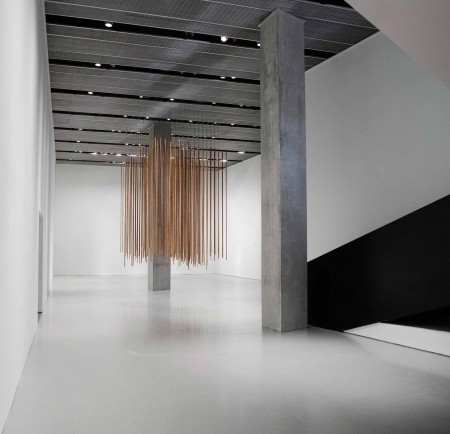What are your ambitions as an artist?
To work my fingers to the bone, as long as it makes me happy! Also to create works that revolve around human/environmental interactions. I will continue to explore new materials and discover new places in which they resonate.
Describe your art in its current form. What do you think is important -for your work to work?
My practice engages in a dialogue between place, form and material. I think of art as transient. A museum is designed and built to last indefinitely and remain constant. I create work in my studio on a comparatively quick timeline. It is displayed in various places until it may find a more permanent home for display. It is important for my work to remain nimble in its presentation. My pieces reflect the spaces in which they are displayed, making the viewer more aware of their surrounding environment. I keep materials and form specific yet minimal to help create a graceful conversation between art and site.
Where did you grow up? Were you exposed to art or artists as a child?
A small rural town. Reidsville, North Carolina.
No, not particularly. Outside of maybe Bob Ross on PBS, haha! I was however exposed to several artisans in my youth that did instill a value of craftsmanship that still resonates within my work today. Growing up in a place where the things you made were seen as valuable by their relevance and usefulness, a great deal of importance was put on how well things were crafted.
Were there any experiences you had as a child or young adult that you consider to be formative for your identity as an artist today?
Time spent on our family farm afforded me a close relationship with nature and a rich understanding into our role as stewards of the land. As a young adult I began to discover how powerful beauty can be.
I identify with the quiet or gentle sensibility that your work presents-Do you think this is a fair description? Is this important to you?
I believe so. These quiet and gentle qualities you suggest, allow the work to become approachable allowing the viewer to engage and create a personal dialogue with the work. When I am working in studio I am engaging in a dialogue with materials. I aim to discover their intrinsic qualities. These qualities are what I make work about. Once the materials have a specific voice, I try to find places or configurations that bring out this voice. This is the dialogue between material, form and place I spoke of earlier.
Your recent work mostly takes the form of site-specific sculptural installation. I think that this kind of work has to change the way we experience or imagine the space that it engages, otherwise it can be purely decorative or worse; describe some recent projects of yours that accomplish this and how.
I agree. Two recent projects come to mind here. They were both displayed in gallery spaces that had very distinct architectural features, or qualities. These qualities became the foundation for all other decisions pertaining to these works. Allowing material selection to enhance the viewer’s perception of space and the volume of the site. This awareness is the crux of these projects. These subtle relationships allow the work to stand in contrast to the gallery without becoming an object within, but more of an extension of the architecture. One of my most recent works is Sojourn, that just came down at the Contemporary Arts Center. It deals directly with how characteristics of material and form help to define place. This project engaged the vertical space in the second floor large room of the CAC, designed by the recently deceased Zaha Hadid. By reflecting the movements of the existing architecture, Sojourn became an extension, creating a scale that was resolutely human. However the timbers reaching upward claimed the volume and surrounding space for the sculpture. Constructed of lumber sourced from a home built at the turn of the 20th century in the Camp Washington neighborhood, this piece connects directly with the city itself. Material choices helped define the title, Sojourn. The heart pine used in this project was harvested from timber found within first growth forests. Easily 300 to 500 years old when milled into the flooring of this home, there is a great history beyond the time spent in Cincinnati. I cut the wood into long thin pieces and joined them end on end to create a forest of even longer spires that hung down to human height.
Is there a site in Cincinnati that you have observed that you would love to engage?
I have dreamed of a large scale project that utilizes vacant lots throughout the city that could be observed from one of Cincinnati’s many overlooks. Speaking to the unique geography of the city.
–Emil Robinson



